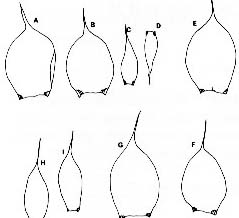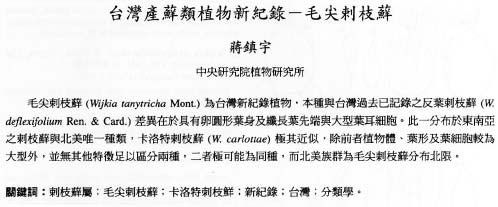Bot. Bull. Acad. Sin. (1996) 37: 147-150
Chiang — Wijkia tanytricha in Taiwan
Wijkia tanytricha (Mont.) Crum (Musci, Sematophyllaceae),
a new record to the moss flora of Taiwan
Tzen-Yuh Chiang
Institute of Botany, Academia Sinica, Nankang, Taipei, Taiwan 115, Republic of China
(Received October 11, 1995; Accepted December 14, 1995)
Abstract. Wijkia tanytricha (Mont.) Crum is a new record to the moss flora of Taiwan. The species is distinguished from W. deflexifolium (Ren. & Card.) Crum, the other species of Wijkia in Taiwan, and characterized by having broadly ovate leaves with a long, filiform acumen and enlarged alar cells. Wijkia tanytricha, distributed in southeast Asia, is related to W. carlottae, a Canadian species, in sharing foliose pseudoparaphyllia and leaf shape. No qualitative characteristics can distinguish these two taxa, although the plants, leaves, and leaf cells of Wijkia tanytricha are larger than those of W. carlottae. I suppose that W. carlottae may be conspecific with W. tanytricha.
Keywords: New record; Taiwan; Wijkia; Wijkia tanytricha; Wijkia carlottae.
Introduction
Wijkia Crum, a moss genus of the Sematophyllaceae, is distributed mainly in the Old World (25 species) and the Americas (one species in North America and three species in South America) (Buck, 1986). Wijkia is distinguished from other genera of the Sematophyllaceae and characterized by having unevenly thickened exothecial cells (vs. collenchymatous cells in other genera of Sematophyllaceae) with thick vertical walls and thin transverse ones (Buck, 1986) and differentiated stem- and branch-leaves. Three sections were classified (Buck, 1986): sect. Wijkia based on type W. extenuata (Brid.) Crum; sect. Andoa based on type W. tanytricha (Mont.) Crum; and the African sect. Acanthocladiopsis, based on type W. trichocoleoides (C. Muell.) Crum. Two species were previously known as Acanthocladium sensu Broth. (Natürl. Pflanzenfam. ed. 2, 11: 412. 1925, non Acanthocladium Mitt., Proc. Linn. Soc. N. S. Wales 7: 102. 1882; an illegitimate homonym of flowering plant genus replaced by Wijkia, cf. Crum, 1971) from Taiwan, i.e. A. deflexifolium (Mitt.) Ren. & Card. and A. semitortipilum (C. Muell.) Fleisch. (cf. Kuo and Chiang, 1987). Gangulee (1980) excluded Hypnum semitortipilum C. Muell. nom. nud. (the latter species). In my survey of bryoflora of Mt. Yushan (Chiang, 1989), the highest mountain in Taiwan, Wijkia tanytricha (Mont.) Crum, a new record, is found.
Taxonomy of Wijkia in Taiwan
Wijkia is distinguished from its relative, Brotherella, by having unevenly thickened exothecial cells, thin-walled alar cells, and a contracted leaf-base. Two species of Wijkia are distributed in Taiwan.
Wijkia Crum, The Bryologist 74: 172. 1971.
Plants medium to robust; yellow-green, shiny. Stems creeping, irregularly bipinnately branched; pseudoparaphyllia foliose. Stem- and branch-leaves differentiated; stem leaves oblong-lanceolate to lanceolate, apex abruptly tapering; branch leaves lanceolate to ovate-lanceolate, gradually acuminate; costa double or absent; cells linear; alar cells inflated, colored. Dioicous. Setae long, smooth; capsules horizontal, cylindrical, asymmetric, exothecial cells unevenly thickened; operculum rostrate; peristomes double, exostome teeth cross-striolate below, papillose above, endostomes with a high basal membrane, segments keeled, cilia 2.
Key to Species of Wijkia Crum in Taiwan
1. Leaf ovate-lanceolate with tips deflexed W. deflexifolia
1. Leaf broadly ovate with straight, abruptly narrowing tips W. tanytricha
1. Wijkia tanytricha (Mont.) Crum, The Bryologist 74: 174. 1971. Figure 1
Illustrations: Gangulee (1980) f. 946; Brotherus (1925) f. 721.
Stem-leaves ovate with an abruptly tapering, long acumen; cells linear, smooth; alar cells enlarged and inflated, 2 to 3 rows; branch-leaves oblong with a long acumen. Pseudoparaphyllia foliose.
Specimen examined. TAIWAN. CHIAYI HSIEN: upper Tung-Pu, in Tsuga forest, on fallen log, 2,500 m alt., 17 Jul 1987, T. Y. Chiang 20370 (MO).
Additional specimen examined. NEW GUINEA. 18 Jun 1968, W. A. Weber & D. McVean 34877 (MO).

